
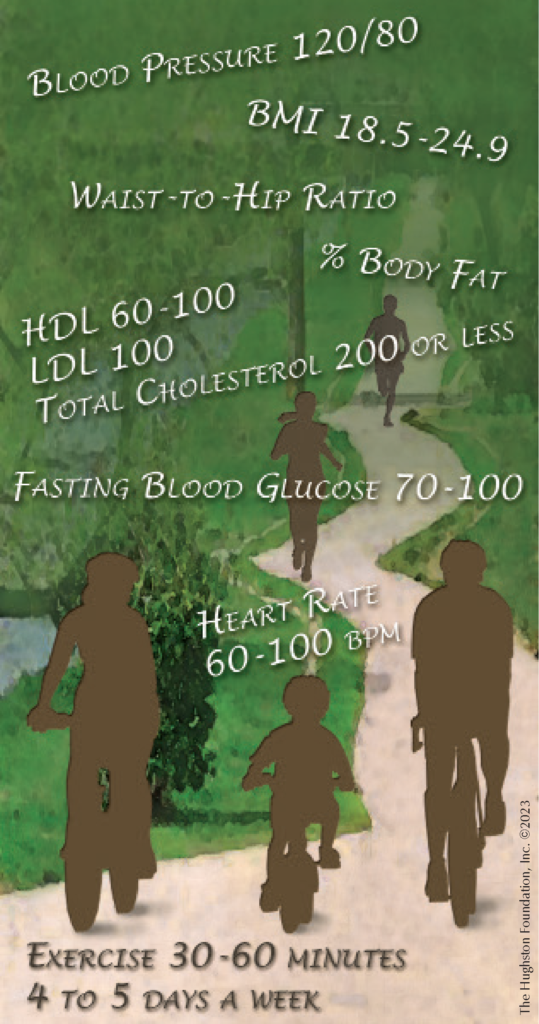 Over the past 25 years, life expectancy has increased year after year for both men and women. Not only are people living longer, they are living healthy, active lives. People are staying healthy to a more advanced age partly because of improvements in the treatment of injury and illness and partly because researchers have focused on the prevention of disease.
Over the past 25 years, life expectancy has increased year after year for both men and women. Not only are people living longer, they are living healthy, active lives. People are staying healthy to a more advanced age partly because of improvements in the treatment of injury and illness and partly because researchers have focused on the prevention of disease.
The foundation of disease prevention includes being at a healthy weight, exercising regularly, eating a balanced diet, and having your health status evaluated during a physical examination. From your physical exam, there are some key numbers you can learn about yourself and your health. The numbers can reveal how well you are, and they can show in which areas you need improvement. Most importantly, the numbers can help you plan, set goals, and change habits to live a healthier, longer life.
Your weight
Excess weight can place you at a higher risk for certain diseases, such as heart disease, high blood pressure, type 2 diabetes, gallstones, breathing problems, and some cancers. For this reason, the first step toward a healthier life is to step on a scale. Once you know how much you weigh, you can determine if you are overweight, underweight, or at your ideal weight. Other basic numbers relevant to your weight include amount of body fat, body mass index, and waist-to-hip ratio.
Body fat
Determining the percentage of your body fat can help to determine your ideal weight. Some scales can calculate percentage of body fat, but you can get a truer number if you seek the advice of a fitness professional who can complete skinfold measurements and calculate it for you. Table 1 shows the range of body fat percentages for men and women. The formula for calculating one’s ideal weight is your percentage of body fat times your current weight, which equals your fat weight. Subtract your fat weight from your current weight to get your lean weight. For a female, divide .78 into your lean weight; for a male, divide .84 into your lean weight to get your ideal weight (Fig. 1).
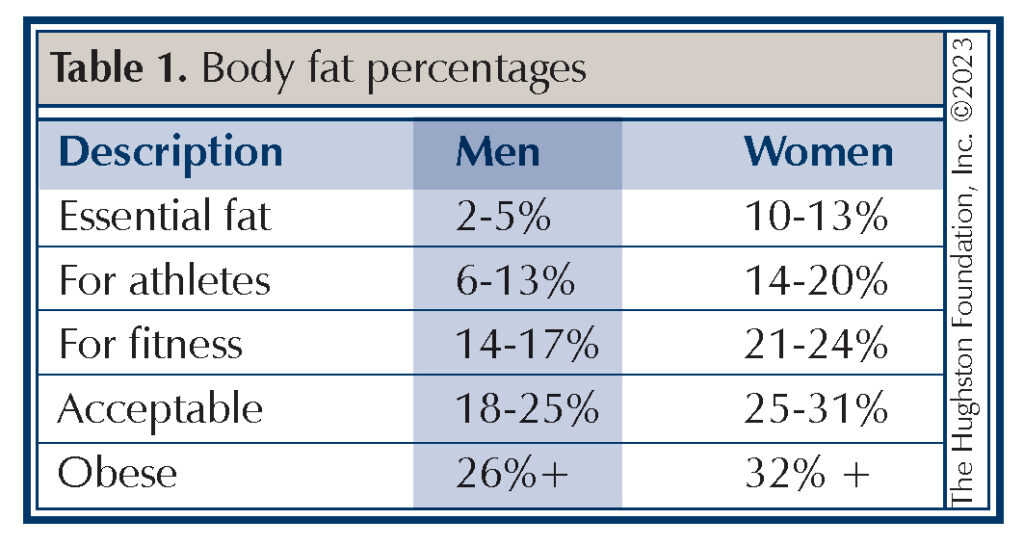
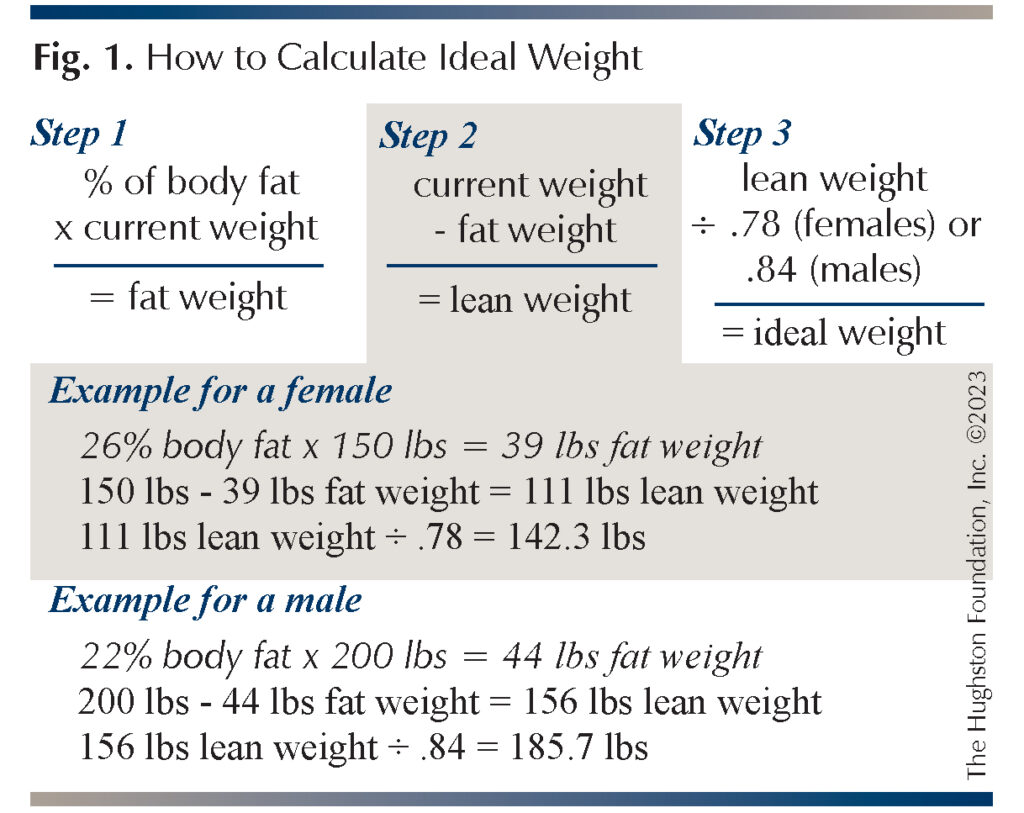
Body mass index
If you don’t have access to a fitness professional who can complete skinfold measurements for you, body mass index (BMI) is often used instead due to its simplicity. BMI uses only body weight and height and does not take into account overall body composition, including body fat; therefore, although it is widely used, it can be a poor indicator of obesity in some populations. The normal BMI range for men and women is between 18.5 and 24.9 (Table 2). Some home digital scales can calculate BMI or you can go to the Internet and use an online calculator by keying in your height and weight. When stepping on the scale, keep in mind that you are weighing muscle, bones, and fat, that is why BMI can be misleading and not always a good way to determine healthy weight. BMI can be a poor measurement of body fat for athletes or people who have a muscular build, and it can be inaccurate in older people who have lost muscle mass.
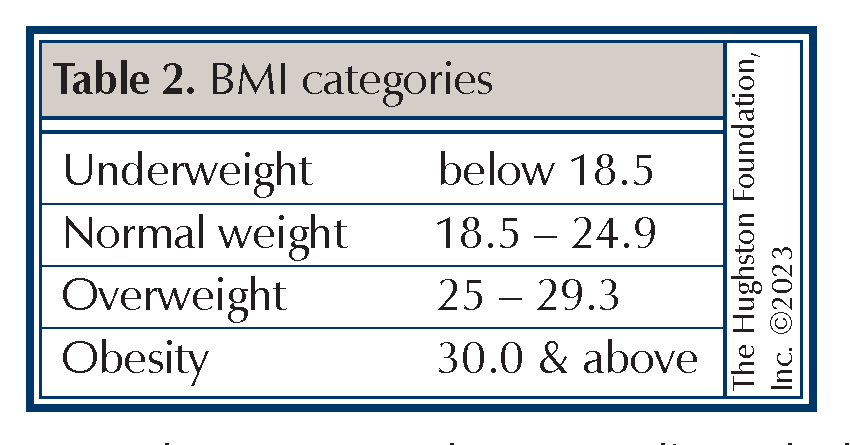
Waist-to-hip ratio
Research has shown that people who have an “apple-shaped” body, or who have more weight around the waist, face higher health risks than those with a “pear-shaped” body, or who carry extra pounds around the hips. To determine if you have a healthy waist-to-hip ratio, use a measuring tape to measure the circumference of your hips at the widest part of your buttocks. Then measure your waist at the smaller circumference of your waist, just above your belly button. Divide your waist measurement by your hip measurement to determine the ratio. If the ratio is greater than .86 in women and .95 in men, the measurement can be associated with an increased risk for heart disease.
Weight loss
Weight loss can be accomplished by reducing the number of calories you consume or by increasing the number of calories you burn through exercise. In order to lose 1 pound a week, the formula is as follows:
Multiply 10 times your current body weight to get the calories you need to maintain your current weight. To lose 1 pound a week reduce your caloric intake by 500 calories a day. Females should not consume less than 1,200 calories a day and males should not consume less than 1,500 calories a day (Fig. 2).

Health screening numbers
During your physical exam, your doctor’s office staff will conduct a number of health screenings, such as checking your blood pressure and drawing blood to send to a lab. Your doctor will then review your lab report and other test results and let you know if you have any areas of concern.
Blood pressure
One of the most dangerous aspects of high blood pressure, or hypertension, is that you may not know you have it. Ideal blood pressure is 120/80, or 120 systolic and 80 diastolic. Blood pressure that exceeds 139 systolic and 89 diastolic should be monitored by your physician.
Your healthcare provider should also check your heart rate. Your heart rate should be between 60 and 100 beats per minute. A low heart rate at rest implies that your heart is functioning effectively and that you have good cardiovascular fitness. Exercise and diet can help improve your resting heart rate and blood pressure.
Cholesterol
Know both your high-density lipoprotein (HDL) level, which is your good cholesterol, and your low-density lipoprotein (LDL) level, which is your bad cholesterol. The National Institutes of Health recommends that LDL numbers stay under 100 and HDL is kept above 40. The more HDL you have, the better your chances of not experiencing heart disease. Cholesterol/HDL ratio is the ratio of your total cholesterol to your good cholesterol. The ideal ratio is between 3.5 and 4 and the lower the ratio, the better. Research indicates that for every 1 unit increase in HDL the risk of heart disease drops by as much as 3%.
Triglycerides
Triglycerides are fats that come from the food you eat, as well as those produced by your body. Elevated triglycerides, in combination with high total cholesterol, low HDL, and high LDL can cause an increased risk of developing heart disease. The fats can often be brought under control through a low fat diet and medication. Evidence shows that high cholesterol and triglyceride levels can be hereditary; therefore, it should be monitored regularly by your physician. Generally, no more than 10% to 20% of your diet should be fat.
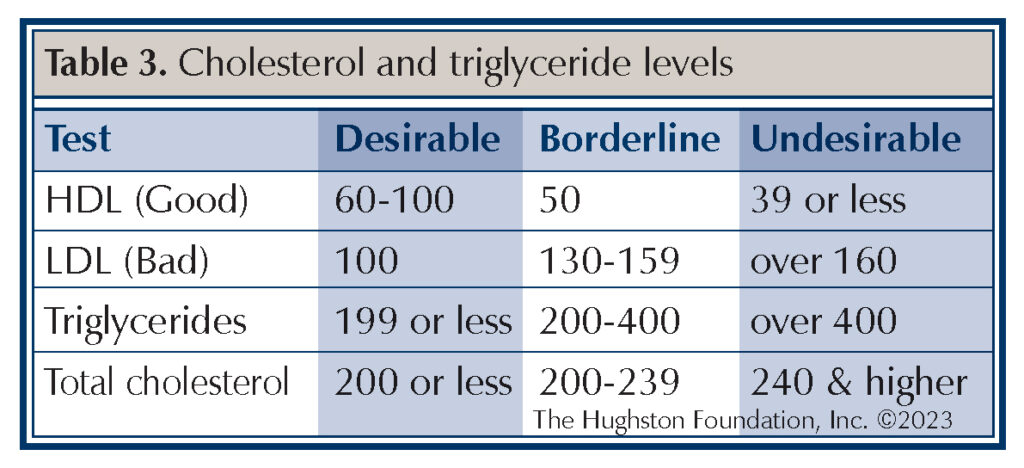
Blood glucose
The American Diabetes Association has recently released new fasting blood glucose guidelines. Fasting blood glucose between 100 and 125 signals prediabetes and anything above 126 indicates a need for evaluation. Diet and exercise can help prevent or manage diabetes. If diabetes isn’t managed, it can lead to disease and health complications, such as heart attack, stroke, amputation, blindness, kidney failure, and nerve damage.
Liver enzymes
Depending on your medical history and the medications you take, your doctor will check your liver enzymes. Elevation of the enzymes can be caused by alcohol, some over-the-counter drugs, prescription medications, and medical conditions, such as liver disease and heart disease. Acetaminophen (Tylenol), cholesterol reducing drugs, and blood pressure medications are common offenders.
Blood count
A complete blood count (CBC) provides information about your red blood cells, white blood cells, platelets, hemoglobin (the oxygen carrying capacity of the blood), and hematocrit (the percentage of red cells to the total volume of blood). The test results can help your physician determine why you are having specific symptoms.
Exercise
Last but not least, exercise is an essential part of a healthy lifestyle. Do some type of aerobic exercise, such as jogging, walking, swimming, cycling, or aerobic dance, 30 to 60 minutes a day, 4 to 5 times each week. Include some flexibility exercises in your program and some weight resistance exercise, as well. Find some type of activity or several activities you enjoy doing. Participating in something you enjoy doesn’t seem like exercise, which means you are more likely to do it regularly.
Your overall fitness level and your health often determine your outlook on life. If you feel good, life is always brighter. A friend of mine once said “We live our lives between first and second base. You will never know what it is like to steal second if you don’t give it a try. So put on your best shoes and your most comfortable britches and just do it.” Consistency is the foundation of any diet and exercise program; it can determine your success or failure. Your goal should be to be healthy at any size.
Author: William Etchison, MS | Columbus, Georgia
Last edited on August 3, 2023